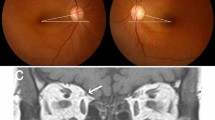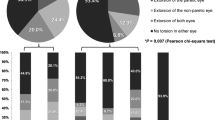Abstract
Purpose
The purpose of our study was to determine whether ocular sighting dominance may influence the ocular torsion in patients with unilateral congenital superior oblique palsy (UCSOP).
Methods
This retrospective study included 22 UCSOP patients with radiologic evidence of unilateral superior oblique muscle hypoplasia on orbital magnetic resonance imaging and 66 healthy individuals with normal ocular motility as controls. Ocular torsion was assessed both quantitatively and qualitatively using digital fundus photography. The disc-fovea angle (DFA) was measured quantitatively using image software on a computer screen. All fundus photographs were qualitatively graded as normal torsion, extorsion, or intorsion in all subjects, based on the location of the optic disc relative to the fovea, according to the Bixenman and von Noorden’s criteria. Ocular sighting dominance was assessed by the hole-in-the-card test and the pointing test. The Mann-Whitney U test and Fisher’s exact test were used to determine the association between the ocular sighting dominance and the ocular torsion.
Results
The median DFA was significantly larger in the eyes of patients with UCSOP (9.1° in the paretic eyes and 9.3° in the non-paretic eyes) than the eyes of the control group (4.3°, p < 0.001 for both). Ocular dominance tests displayed that, among 22 patients, 11 were paretic eye dominant and the other 11 were non-paretic eye dominant. The sighting-dominant eyes demonstrated significantly smaller median DFA than the non-dominant eyes (8.3° and 10.7°, respectively, p = 0.033), regardless of which eyes were paretic. Ten eyes of ten patients had extorsion, none had intorsion, and all the eyes of remaining 12 patients had no abnormal torsion, qualitatively. All the eyes showing extorsion in fundus photography were non-dominant eyes, regardless of whether the eyes were paretic or non-paretic.
Conclusions
Our findings illuminate the importance of considering ocular sighting dominance for properly assessing ocular torsion in patients with UCSOP. Ocular sighting dominance may have an influence on objective ocular torsion in a way that decreases the torsion in the dominant eye, thereby hindering the abnormal ocular torsion from appearing in that eye.

Similar content being viewed by others
References
von Noorden GK, Campos EC (2002) Paralytic Strabismus. In: Binocular vision and ocular motility, 6th edn. Mosby, St. Louis, pp 414–457
Phillips PH, Hunter DG (1999) Evaluation of ocular torsion and principles of management. In: Rosenbaum AL, Santiago AP (eds) Clinical strabismus management. Saunders, Philadelphia, pp 52–72
von Noorden GK (1984) Clinical and theoretical aspects of cyclotropia. J Pediatr Ophthalmol Strabismus 21(4):126–132. doi:10.1007/s00417-007-0622-5
Guyton DL (1983) Clinical assessment of ocular torsion. Am Orthopt J 33:7–15
Rossler F (1920) Die Hohenstellung des Blinden Fleckes in normalen Augen. Arch Augenheilk 86:55–88
Herzau V, Joos-Kratsch E (1984) Objective and subjective evaluation of cyclovergence and cyclofusion. Doc Ophthalmol 58:85–90
Sharma P, Prasad K, Khokhar S (1999) Cyclofusion in normal and superior oblique palsy subjects. J Pediatr Ophthalmol Strabismus 36:264–270
Olivier P, von Noorden GK (1982) Excyclotropia of the nonparetic eye in unilateral superior oblique muscle paralysis. Am J Ophthalmol 93:30–33
Lefèvre F, Péchereau A (2009) Study of optic nerve head-fovea angle with retinophotography in congenital fourth nerve palsy. J Fr d’ophtalmologie 32:263–267. doi:10.1016/j.jfo.2008.12.006
Na KS, Lee SY, Lee YC (2007) Ocular torsion in unilateral superior oblique palsy. J Korean Ophthalmol Soc 48:1388–1393. doi:10.3341/jkos.2007.48.10.1388
Porac C, Coren S (1976) The dominant eye. Psychol Bull 83:880–897
Johansson J, Seimyr GÖ, Pansell T (2015) Eye dominance in binocular viewing conditions. J Vis 21:1–17. doi:10.1167/15.9.21
Portal JM, Romano PE (1998) Ocular sighting dominance: a review and a study of athletic proficiency and eye-hand dominance in a collegiate baseball team. Binocul Vis Strabismus Q 13:125–132
Quah BL, Lu Y, Smith D (2001) The association of ocular dominance and the preferred eye for fixation in intermittent exotropia: a guide to choosing the eye for unilateral surgery. Am Orthopt J 51:111–115. doi:10.3368/aoj.51.1.111
Koo BS, Cho YA (1996) The relationship of dominant eye, dominant hand, and deviated eye in strabismus. J Korean Ophthalmol Soc 37:1277–1282
Ryu HJ, Kim WS, Lee JH, Min SW, Kim SJ, Lee YS, Lee YH, Nam SW, Eo GS, Seo SG, Nam MH (2010) Asan medical information system for healthcare quality improvement. Healthc Inform Res 16:191–197. doi:10.4258/hir.2010.16.3.191
Yang HK, Lee DS, Kim JH, Hwang J-M (2015) Association of superior oblique muscle volumes with the presence or absence of the trochlear nerve on high-resolution MR imaging in congenital superior oblique palsy. Am J Neuroradiol 36:774–778. doi:10.3174/ajnr.A4202
Shin KH, Lee HJ, Lim HT (2013) Ocular torsion among patients with intermittent exotropia: relationships with disease severity factors. Am J Ophthalmol 155:177–182. doi:10.1016/j.ajo.2012.07.011
Roth HL, Lora AN, Heilman KM (2002) Effects of monocular viewing and eye dominance on spatial attention. Brain 125:2023–2035. doi:10.1093/brain/awf210
Bixenman WW, von Noorden GK (1982) Apparent foveal displacement in normal subjects and in cyclotropia. Ophthalmology 89:58–62
Mudgil AV, Walker M, Steffen H, Guyton DL, Zee DS (2002) Motor mechanisms of vertical fusion in individuals with superior oblique paresis. J AAPOS 6:145–153. doi:10.1067/mpa.2002.122521
Lee DH, Lee SJ, Park SH (2004) Ocular torsion in normal Korean population. J Korean Ophthalmol Soc 45(5):797–802
Jethani J, Seethapathy G, Purohit J, Shah D (2010) Measuring normal ocular torsion and its variation by fundus photography in children between 5–15 years of age. Indian J Ophthalmol 58(5):417–419. doi:10.4103/0301-4738.67060
Rohrschneider K (2004) Determination of the location of the fovea on the fundus. Invest Ophthalmol Vis Sci 45(9):3257–3258
Chaudhuri Z, Demer JL (2013) Sagging eye syndrome: connective tissue involution as a cause of horizontal and vertical strabismus in older patients. JAMA Ophthalmol 131:619–625. doi:10.1001/jamaophthalmol.2013.783
Clark RA, Miller JM, Rosenbaum AL, Demer JL (1998) Heterotopic muscle pulleys or oblique muscle dysfunction? J AAPOS 2:17–25. doi:10.1016/S1091-8531(98)90105-7
Sato M (1999) Magnetic resonance imaging and tendon anomaly associated with congenital superior oblique palsy. Am J Ophthalmol 127:379–387. doi:10.1016/S0002-9394(98)00329-8
Sato M, Iwata EA, Takai Y, Hikoya A, Koide YM (2008) Superior oblique palsy with class III tendon anomaly. Am J Ophthalmol 146:385–394. doi:10.1016/j.ajo.2008.05.013
Helveston EM, Krach D, Plager DA, Ellis FD (1992) A new classification of superior oblique palsy based on congenital variations in the tendon. Ophthalmology 99:1609–1615. doi:10.1016/S0161-6420(92)31759-2
Yang HK, Kim JH, Hwang J-M (2012) Congenital superior oblique palsy and trochlear nerve absence: a clinical and radiological study. Ophthalmology 119:170–177. doi:10.1016/j.ophtha.2011.06.038
Kushner BJ, Hariharan L (2009) Observations about objective and subjective ocular torsion. Ophthalmology 116:2001–2010. doi:10.1016/j.ophtha.2009.03.047
Funding
No funding was received for this research.
Author information
Authors and Affiliations
Corresponding author
Ethics declarations
Conflict of interest
All authors certify that they have no affiliations with or involvement in any organization or entity with any financial interest (such as honoraria; educational grants; participation in speakers’ bureaus; membership, employment, consultancies, stock ownership, or other equity interest; and expert testimony or patent-licensing arrangements), or non-financial interest (such as personal or professional relationships, affiliations, knowledge or beliefs) in the subject matter or materials discussed in this manuscript.
Ethical approval
All procedures performed in studies involving human participants were in accordance with the ethical standards of the institutional and/or national research committee and with the 1964 Helsinki Declaration and its later amendments or comparable ethical standards.
Informed consent
Informed consent was obtained from all individual participants included in this study.
Rights and permissions
About this article
Cite this article
Kim, D.H., Kim, H. & Lim, H.T. The influence of ocular sighting dominance on Fundus torsion in patients with unilateral congenital superior oblique palsy. Graefes Arch Clin Exp Ophthalmol 255, 2473–2479 (2017). https://doi.org/10.1007/s00417-017-3778-7
Received:
Revised:
Accepted:
Published:
Issue Date:
DOI: https://doi.org/10.1007/s00417-017-3778-7




